Ants are often the first sign that something is wrong on your property. Either the factors that attract invasive pests are piling up or easy access points aren’t being addressed. Likely, it’s both. Where this becomes a true hazard is when the ants crawling around your property are more damaging than you expect them to be. With carpenter ants, this surprise feature of causing destruction is exactly why you need to keep up on proper ant prevention and control.

Carpenter Ants: What To Know
What makes carpenter ants so much more dangerous than other species is their habit of chewing through the wood in order to create incubation chambers for their eggs. Just like termites, carpenter ants can lead to structural damage and costly repairs. Unlike termites, however, carpenter ants don’t eat the wood that they bore through. Instead, they are attracted by all the same things that other invasive ants are. That’s why general pest control is necessary, but it’s also important to understand how carpenter ant colonies first start. Both carpenter ants and termite populations are started by winged swarms made up of reproductive members of existing colonies. Those swarmers leave their territories, typically during the early spring, to find new areas to colonize. They target attractive yards and gardens that provide them easy access to wood and the potential for expansion. This is why you have to make sure you’re keeping up on pest prevention long before flying ant swarms take to the skies.
What Attracts Carpenter Ants?
To address preventative measures, you really need to understand what attracts ant populations to properties in the first place. Some of these factors apply to all ants and some are specifically a concern with carpenter ants:
- Food: Carpenter ants are attracted by sugary aromas, protein-rich meats, and even dead insects. Their varied diet means that many types of food traces can attract them.
- Trash: The food waste found in trash receptacles can also attract ants, which will forage around in dirty places without a second thought.
- Wood: Naturally, carpenter ants will be attracted to wood, both inside and outdoors. Firewood or other yard debris make for easy targets for carpenter ant swarms.
The Damage They Can Cause
Most ants aren’t destructive, which is why we often don’t pay them a second thought. But while small, black carpenter ants look a lot like other ant species, you don’t want to realize too late that a pest population has actually been causing huge amounts of damage. Carpenter ants leave much more visible marks on household woods than termites, which almost exclusively attack from subterranean, non-surface soils and woods. However, carpenter ants can keep much of the evidence of their activity hidden, too, especially when they nest inside of walls or work their way inside from hidden outdoor areas. Even if you notice the Swiss-cheese-like holes that they leave in household woods, you won’t necessarily be able to address the entire population. The reproductive members of their colonies are hidden deep within their tunnels, and only professionals can truly address them.
Pest Protection Done Right
Carpenter ants are dangerous and difficult to eliminate. While at-home prevention measures, like general cleaning and maintenance, can help you contend with ant infestations, only professional resources are guaranteed to work. Don’t take a chance that the ant population on your property is actually destructive carpenter ants. Instead, contact experts once you notice any signs of pests on your property. At Pest & Termite Consultants, we can make sure that ants are identified properly and that your entire property is inspected for signs of damage. If pests are already there, it’s important to act quickly before they can do serious property damage.
For true protection from carpenter ants and other wood-boring pests, contact Pest & Termite Consultants today.

